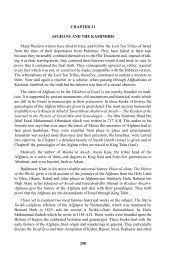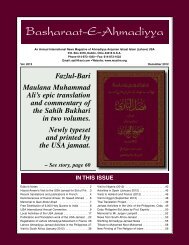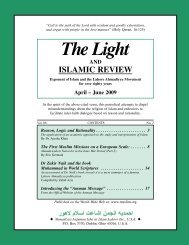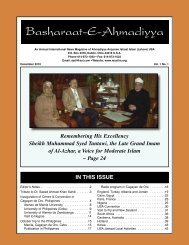From Arabia to the Himalayas - The Lahore Ahmadiyya Movement in ...
From Arabia to the Himalayas - The Lahore Ahmadiyya Movement in ...
From Arabia to the Himalayas - The Lahore Ahmadiyya Movement in ...
Create successful ePaper yourself
Turn your PDF publications into a flip-book with our unique Google optimized e-Paper software.
<strong>The</strong> <strong>Lahore</strong> <strong>Ahmadiyya</strong> <strong>Movement</strong> and <strong>the</strong> Reform<br />
of Albanian Islam <strong>in</strong> <strong>the</strong> Inter-War Period<br />
by Nathalie Clayer<br />
In 1927, after seven years of freshly acquired <strong>in</strong>dependence, Albania began <strong>to</strong> stabilise and<br />
undergo political reform. 1 <strong>The</strong> ‘umbilical cord’ that used <strong>to</strong> b<strong>in</strong>d <strong>the</strong> Islamic Community of<br />
this small Balkan country 2 with a Muslim majority <strong>to</strong> Istanbul was at that time once and for<br />
all severed. On <strong>the</strong> one hand, <strong>the</strong> sett<strong>in</strong>g up of national religious structures <strong>in</strong> 1923, on <strong>the</strong><br />
o<strong>the</strong>r <strong>the</strong> abolition of <strong>the</strong> Caliphate and <strong>the</strong> suppression of <strong>the</strong> medrese’s [Medrese is <strong>the</strong><br />
Turkish form of <strong>the</strong> Arabic madrasah — Transla<strong>to</strong>r.] <strong>in</strong> Turkey <strong>in</strong> 1924, as well as <strong>the</strong><br />
clos<strong>in</strong>g of <strong>the</strong> tekke’s [Dervish lodges (Turkish, from Arabic) — Transla<strong>to</strong>r.] <strong>the</strong> follow<strong>in</strong>g<br />
year, brought <strong>to</strong> an end <strong>the</strong> organic l<strong>in</strong>ks that were <strong>in</strong> existence from a religious po<strong>in</strong>t of view<br />
between this former prov<strong>in</strong>ce of <strong>the</strong> Ot<strong>to</strong>man Empire and <strong>the</strong> centre on which it depended. It<br />
was at that po<strong>in</strong>t that <strong>the</strong> leaders of this Islamic Community received a letter from <strong>the</strong><br />
‘Muslim Community of India’. <strong>The</strong> latter <strong>in</strong>troduced itself as hav<strong>in</strong>g missions <strong>in</strong> England,<br />
Germany, America and Africa, as hav<strong>in</strong>g already converted “over a hundred English people”<br />
and “about a hundred Germans” and hav<strong>in</strong>g built mosques <strong>in</strong> England and Germany: an<br />
Islamic community which seems, <strong>the</strong>refore, <strong>to</strong> display a missionary dynamism <strong>in</strong> <strong>the</strong> very<br />
heart of Europe.<br />
In <strong>the</strong> follow<strong>in</strong>g years, a relationship would be established between <strong>the</strong> Albanian<br />
Islamic Community and this ‘Muslim Community of India’, or more exactly of <strong>Lahore</strong>, <strong>in</strong> this<br />
case <strong>the</strong> <strong>Ahmadiyya</strong> Anjuman Isha’at al-Islam (‘<strong>Ahmadiyya</strong> Association for <strong>the</strong> Propagation<br />
of Islam). 3 What form did <strong>the</strong>se connections take and why this <strong>in</strong>fluence on <strong>the</strong> part of an<br />
Indian missionary organisation among <strong>the</strong> Albanian Muslims <strong>in</strong> <strong>the</strong> Inter-War Period? It is<br />
questions such as <strong>the</strong>se that this article will attempt <strong>to</strong> address.<br />
Picture with caption: <strong>The</strong> first letter received from <strong>the</strong><br />
Anjuman by <strong>the</strong> Albanian Islamic Community, accompanied<br />
by a pho<strong>to</strong>graph of <strong>the</strong> Berl<strong>in</strong> mosque<br />
<strong>From</strong> <strong>Lahore</strong> <strong>to</strong> Tirana: propagat<strong>in</strong>g an Islam for <strong>the</strong> spiritual conquest of<br />
Europe<br />
<strong>The</strong> only European country with a Muslim majority, Albania could not do o<strong>the</strong>rwise<br />
than be a target of choice for a Muslim missionary organisation such as <strong>the</strong> <strong>Lahore</strong> branch of<br />
<strong>the</strong> Ahmadi movement, active <strong>in</strong> Europe s<strong>in</strong>ce 1912. In 1927, when <strong>the</strong> representatives of <strong>the</strong><br />
<strong>Ahmadiyya</strong> Anjuman Isha’at al-Islam made contact with <strong>the</strong> Albanian Islamic Community,<br />
<strong>the</strong>y had, <strong>in</strong>deed, already successfully established a mission at Wok<strong>in</strong>g, south of London,<br />
1 Albania acquired <strong>in</strong>dependence <strong>in</strong> 1913, but was occupied by various powers dur<strong>in</strong>g <strong>the</strong> First World War. Only<br />
<strong>in</strong> 1920 did it fully recover that <strong>in</strong>dependence that it lost once aga<strong>in</strong> <strong>in</strong> 1939.<br />
2 By ‘Islamic Community’ with a capital ‘C’ I mean here <strong>the</strong> official Muslim religious <strong>in</strong>stitutions.<br />
3 This denotes a branch of <strong>the</strong> Ahmadi movement, which arose <strong>in</strong> <strong>the</strong> Panjab at <strong>the</strong> end of <strong>the</strong> 19 th Century. Shortly<br />
after <strong>the</strong> death of its founder, Mirza Ghulam Ahmad (d. 1908), this movement split <strong>in</strong><strong>to</strong> two. <strong>The</strong> greater part of<br />
<strong>the</strong> Ahmadi faithful made up <strong>the</strong> Qadiani <strong>Ahmadiyya</strong> <strong>Movement</strong>, beh<strong>in</strong>d <strong>the</strong> son of <strong>the</strong> founder, consider<strong>in</strong>g Mirza<br />
Ghulam Ahmad <strong>to</strong> be a prophet. Ano<strong>the</strong>r group, much less significant numerically and hold<strong>in</strong>g Mirza Ghulam<br />
Ahmad <strong>to</strong> be only a reformer (mujaddid), constituted <strong>the</strong> <strong>Lahore</strong> <strong>Ahmadiyya</strong> <strong>Movement</strong> (Smith, 1956). I shall not<br />
discuss here <strong>the</strong> activity of <strong>the</strong> Qadianis, whose impact <strong>in</strong> Albania was considerably less significant than that of <strong>the</strong><br />
Lahoris.<br />
1


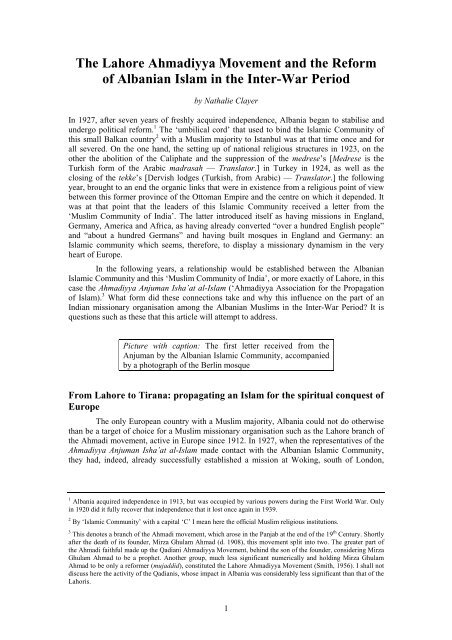
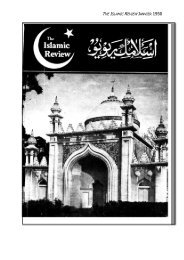
![Part 2] HARD TRIALS NECESSARY TO ESTABLISH TRUTH 69 152 ...](https://img.yumpu.com/11777151/1/167x260/part-2-hard-trials-necessary-to-establish-truth-69-152-.jpg?quality=85)

